
Dave Bitts and his boat Elmarue on May 28, 2024 at Woodley Island marina in Eureka, Calif.
Juliet Grable / JPR
Dave Bitts can bring in over 100 salmon by himself.
“That’s an exceptionally good day. If I catch 20 fish it’s worth the trip,” says Bitts.
At 76, he still fishes for salmon alone. Standing in the cockpit on the stern deck of his wooden trawler, Elmarue, he can keep an eye on all six wires; when one of the lines starts to dance, he brings the fish in, stunning it with his gaff while it’s still in the water. Then he uses the tool to hook the salmon behind the gills and swings it onto the deck.
“By the way, I want that fish cleaned and chilling in a single water flush within half an hour; that’s the standard,” says Bitts. “I want you to enjoy eating it as much as I enjoyed catching it.”
Related: Hundreds of thousands of juvenile Chinook salmon die in Klamath River while moving through dam
Bitts has commercial permits for both crab and salmon. Normally, in late May, he’d be out salmon fishing; instead, he’s just returned from a late crab run and tucked Elmarue into her slip at Woodley Island, a tidy marina in Humboldt Bay right across the waterfront near Eureka’s Old Town.
In April, for the second year in a row, the Pacific Fishery Management Council voted unanimously to close California’s commercial and recreational ocean salmon fishery. The closure was based on woefully low numbers of adult salmon expected to return to several California rivers.
The east end of the marina is stocked with sailboats and pleasure craft, but on the west end you can spot several commercial boats — Inua, Joy Ann, and My Lady, her deck piled high with crab pots.
“There’s not that many anymore, because there’s not much salmon season anymore,” says Bitts.
Decades of attrition
The California Department of Fish and Wildlife cited “ongoing issues associated with drought and climate disruption” as factors leading to the closure of this year’s salmon fishery, which generates $1.4 billion in a normal year. In fact, salmon stocks along the West Coast have been in steep decline for decades, and along with it, the industry that relies on them.
In its heyday, California issued over 7,000 commercial salmon fishing permits. Now there are fewer than 1,000, and only half of those boats are active.
“That is a major economic disaster for our coastal communities and businesses that once thrived up and down the coast,” says Glen Spain, Northwest Regional Director of the Pacific Coast Federation of Fishermen’s Associations. “If you look at the numbers from Crescent City, they’ve lost 95% of their original landings.”

Elmarue at dock in Woodley Island marina near Eureka's Old Town.
Juliet Grable / JPR
The decline is tied to compounding harms, starting with intensive mining and logging that destroyed fish habitat and overfishing that occurred before any environmental laws were in place. Add to that dams that block habitat; diversions that send water to crops and cities, and climate change, which is making many of these challenges worse and adding new concerns on top of them.
Amid this dark news there is one bright spot: deconstruction of four hydroelectric dams on the Klamath River is proceeding rapidly. The removal of these barriers and the ongoing restoration of habitat all along the river should help Klamath salmon rebound in what was once the third largest salmon-producing river on the West Coast.
But will the restoration of Klamath River runs help restore California’s flailing salmon fishing industry?
The answer, not surprisingly, is complicated.
Decades of decline
Commercial, tribal, and recreational fishermen have been some of the strongest and most consistent voices calling for dam removal, in part because diminished runs on the Klamath River often constrain the number of salmon that can be harvested commercially from the ocean.
Salmon typically return to the same rivers in which they were born; while each run is genetically distinct, they all intermingle in the ocean. Ocean harvest levels are set to protect the least abundant runs, so those depressed stocks become the limiting factor.
“You have to close the whole fishery when one of those stocks is particularly weakened…otherwise you risk pushing that weak stock to the brink of extinction — or worse, extinction,” says Spain.
Related: No turning back: The largest dam removal in US history begins
In the early 1980s, Klamath River salmon runs started crashing. The number of adults returning to spawn in the Klamath had by that time plummeted from a pre-dam average of 880,000 to fewer than 50,000 in some years, according to Spain.
For the first time, boats were pulled off the water to protect Klamath River fish. The many fishermen who depended on salmon for their livelihoods were “in shock,” says Spain. “It was clear we had to pay very close attention to the Klamath.”
In 1986, Congress passed the Klamath River Basin Fishery Resources Restoration Act, and a committee formed to address how to restore collapsing Klamath River salmon. The multi-stakeholder group included recreational, sport, commercial, and tribal fishing interests, along with NGOs and, eventually, agricultural interests from the Upper Klamath Basin.
Related: Tribes celebrate release of hatchery-bred coho and Chinook into Klamath River
Early on, Spain identified the Klamath River dams as crucial barriers to recovery, and PCFFA began advocating for their removal. “People laughed in my face,” he recalls.
The movement gained momentum after the massive fish kill in 2002, when up to 78,000 fish, possibly more, died in the Klamath River from infections of a parasite called “ich” and a bacterial pathogen called columnaris. The diseases proliferated thanks to warm water temperatures and large numbers of fish crowding near the river’s mouth. Most of the fish were fall-run adult Chinook that had returned to spawn; an entire generation was lost. Fishermen felt the consequences four years later, in 2006, when the ocean fishery was closed from Monterey, California, to the Oregon-Washington border.
It wasn’t until the utility PacifiCorp, owner of the hydroelectric project, realized that retrofitting the dams to comply with fish passage and water quality requirements was a losing proposition that they aligned with advocates, and dam removal became inevitable.
Hope on the horizon?
Compared to decades of advocacy, deconstruction of the four Lower Klamath Project dams is happening with breathtaking speed.
In theory, adult Chinook should be able to access miles of new habitat above the former dam sites as early as this fall. Water quality should also improve, and with it, a reduction of disease pathogens in the river that kill alarming numbers of juvenile fish almost every year.
Like Sacramento River fall Chinook, Klamath River fall-run Chinook is a “target stock” — that is, one that can be commercially harvested. Federal regulations establish minimum numbers of “spawners” required to ensure the next generation of fish and limit the percentage of these fish that can be caught in the ocean.
Improvement in Klamath River runs should increase the overall number of Chinook that fishermen can harvest in the ocean. But that’s only if the Sacramento River run — historically the “bread and butter” stock for California’s commercial salmon fishermen — stays viable.
“We used to count on there being about half a million Sacramento fish in the ocean of the size that we could keep,” says Bitts. “The trend has been downward for the last 15 years.”
Related: The Klamath River’s Iron Gate comes down, one scoop at a time
“At this point in time, the biggest impact to salmon in terms of their productivity is lack of suitable freshwater habitat for both spawning adults and young fish due to dams, water diversion, disease, and climate change,” says Brett Kormos, Program Manager for the Northern Region Coastal Fisheries at CDFW.
The Sacramento and San Joaquin rivers flow through the Central Valley. There the combination of warm temperatures and low stream flows — made worse by diversions for irrigation and urban water supplies — creates lethal conditions for salmon eggs and young fish, which need cold water to survive. That’s what happened at the height of the drought from 2020 to 2022, and that’s why so few adults returned to the Sacramento River three and four years later.
Fishermen and biologists are also tracking shifts in what salmon eat while they’re in the ocean.
Bitts has noticed “habitat compression”— more fish concentrating in fewer areas to feed. They’re also eating different things, says Kormos — more anchovies, fewer copepods, aka krill. Anchovies contain a substance called thiaminase which can deplete salmon of vitamin B when consumed. Without this essential nutrient, salmon may not be able to spawn successfully.
PCFFA is the largest trade organization representing commercial fishermen on the West Coast. A sister organization called the Institute for Fisheries Resources focuses on research and habitat restoration.
“We at IFR and PCFFA have been working on habitat issues for 50 years, since 1976,” says Bitts, who served as president of PCFFA until 2019. “I feel like we’ve been fighting a retreating rearguard action for all of that time.” Despite winning lawsuits that call for improving river conditions and restoring habitat, stocks are still declining.
Related: Researchers, tribes, residents prepare for a century of sediment released from the Klamath dams
The Klamath River dam removal and restoration could buck that trend, but seeing the changes translate into more abundant salmon runs is a “long game,” warns Kormos. “A lot of the projections that are out there about the full realized benefits are decades into the future — 50 years, 100 years out.”
Getting salmon to cold water above dams may be crucial to their survival, adds Kormos. “I’m optimistic about dam removal itself and the potential for that to happen elsewhere, or for us to start transporting fish over rim dams in California as is done in states to the north.”
Passing the torch

Dave Bitts stands on the deck of the Elmarue on May 28, 2024.
Juliet Grable / JPR
Bitts remembers being a skinny kid fishing off a dock in Bodega Bay and watching the salmon trollers come in.
“I thought then, and I thought ever since, these are the most beautiful boats in the world,” he says. Bitts bought Elmarue in 1985, soon after he’d committed to fishing full time. The boat is just two years older than he is.
Bitts has largely stepped away from politics, though he still tracks developments that affect fish and fishermen. George Bradshaw, another life-long fisherman but several decades younger, has taken on the mantle as PCFFA president, and board members are focused on specific issues, such as the proposed offshore wind farm west of Humboldt Bay. Advocacy is crucial to preserving a way of life that at times seems to be slipping away.
“The next generation [of fishermen] is quite a bit smaller,” says Bitts. “A higher percentage of them are going to have to be politically active.”
As for Bitts, he intends to keep fishing as long as he can. He enjoys being out on the ocean and seeing the wildlife, but, he admits, it’s the thrill of the catch that never grows old.
“When you can see from your spring that fish are biting, that’s like, yes, we’re getting some!” he says. “Then you get to see the fish in the water, you unhook that snap…you’re pulling that fish in hand over hand — that’s quite a high.”